General Atomics MQ-9 Reaper (Predator B)
The Predator B is a larger and more powerful derivative of General Atomics Aeronautical Systems Inc.'s (GA-ASI) successful RQ/MQ-1 Predator multi-mission UAV. Development was begun as a private venture in 1998, but was eventually funded by NASA. The first flight of the prototype occurred in February 2001.
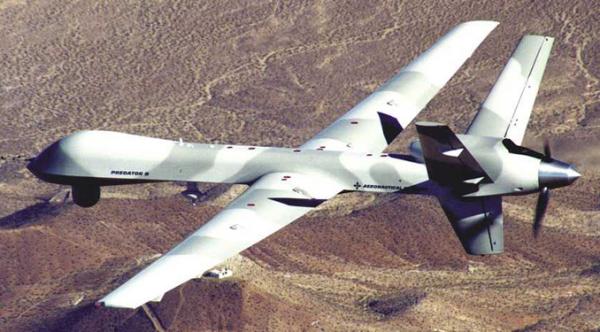 |
| Photo: General Atomics |
| Predator B (YMQ-9A) |
The Predator B is essentially a scaled-up derivative of the RQ/MQ-1 Predator, the major difference in layout being the more conventional upward V-tail. GA-ASI has flown Predator B prototypes with two different powerplants, the first one with a Honeywell TPE-331-10T turboprop and the second one with a Williams FJ44-2A turbofan. The basic equipment suite of the Predator B is similar to that of the RQ/MQ-1 Predator, and the primary mission equipment consists of a Raytheon AN/AAS-52(V) MTS (Multi-Spectral Targeting System) EO/IR sensor turret/laser designator and a General Atomics AN/APY-8 Lynx SAR (Synthetic Aperture Radar). The Predator B can also be used as an armed multi-mission UAV, being able to launch many different types of guided weapons. The Predator B is compatible with the ground-based communications equipment of the MQ-1B Predator system, so that it can supplement and/or replace the latter relatively seamlessly.
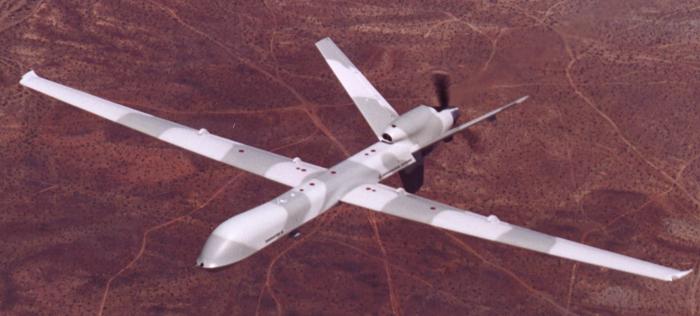 |
| Photo: General Atomics |
| Predator B (YMQ-9A) |
After the U.S. Air Force had successfully "weaponized" its MQ-1 Predator, it became interested in the more powerful Predator B. In February 2003, the designation MQ-9A was allocated to the turboprop-powered variant of the Predator B (the USAF was not interested in the turbofan version), and later that year two YMQ-9A prototypes were purchased. The MQ-9A has significantly higher performance than the original Predator. It has a mission endurance of at least 24 hours at a maximum altitude of 15200 m (50000 ft), and GA-ASI claims a total endurance of up to 27 hours. In 2006, the USAF assigned the official name Reaper to the MQ-9A, and in 2007, the first wing to operate the Reaper was established.
The USAF's MQ-9A armament options include the AGM-114 Hellfire guided missile, as well as GBU-12/B Paveway II, GBU-38/B JDAM, GBU-49/B Enhanced Paveway II and GBU-54/B Laser JDAM guided bombs. In 2018, the USAF claimed that an MQ-9 had shot down a maneuvering target drone in an exercise, using an unspecified air-to-air missile (most likely an AIM-9X Sidewinder). In September 2020, it was confirmed that the MQ-9A can use the AIM-9X Block 2 against cruise-missile like threats.
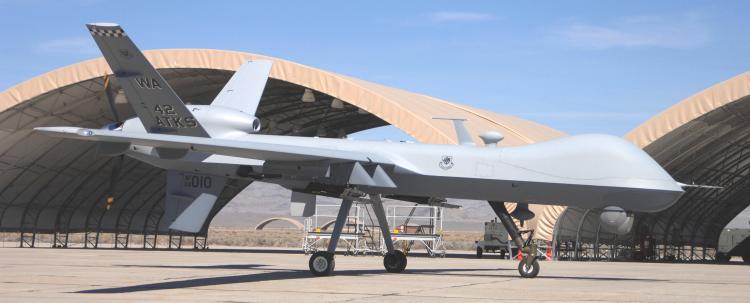 |
| Photo: Senior Airman Larry E. Reid Jr., USAF |
| MQ-9A |
The Reaper had its combat debut in 2007 over Afghanistan, and has since been used extensively in that area, over Iraq and in other Middle East war zones. In 2023/24, the USAF lost more than a dozen Reapers in the Middle East, many of them over Yemen to surface-to-air missiles fired by Houthi rebels. As of 2018, the USAF had ordered 366 Reapers from General Atomics, and by 2021, more than 300 had been delivered. The Air Force has plans to retire its MQ-9A fleet by 2035.
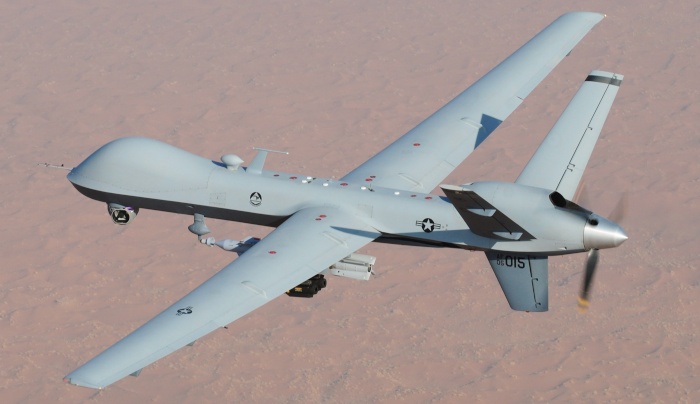 |
| Photo: Lt. Col. Leslie Pratt, USAF |
| MQ-9A |
In 2015, the USAF first flew an extended range Reaper, which could carry external fuel tanks under the wings, and had a sturdier landing gear to manage the higher take-off gross weight. The Air Force reportedly received 38 MQ-9As upgraded to this configuration, which has an endurance for the ISR mission of up to 33 hours.
In 2016, General Atomics introduced an enlarged variant, which it called Predator B ER (Extended Range). The main new feature is a longer wing, with higher internal fuel capacity, more external hardpoints, and improved low-speed handling for shorter take-off and landing runs. The new design allows a maximum endurance of more than 40 hours. GA-ASI is marketing this variant as the SkyGuardian multi-mission long-endurance UAV for military and civilian customers. The aircraft has a payload capacity of 360 kg (800 lb) internal, and 2150 kg (4750 lb) external on 9 hardpoints (8 wing, 1 fuselage). It also features systems on board and in its ground control station, which enable the SkyGuardian to fly seamlessly within civilian controlled air space.
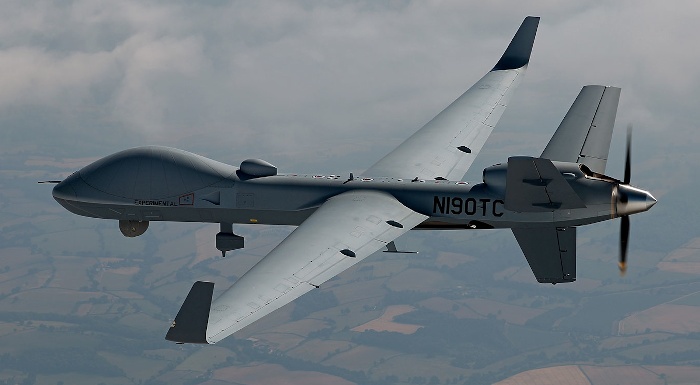 |
| Photo: General Atomics |
| SkyGuardian (MQ-9B) |
The first operational user of the SkyGuardian is the Royal Air Force. The RAF had already announced in 2016, that it intends to replace its 10 MQ-9A Reaper drones with the new Predator B ER variant. The first production aircraft for the RAF were delivered in late 2023. They are designated Protector RG.1 (or RG Mk 1) in British service, and the U.S. DOD has assigned the official MDS designation MQ-9B.
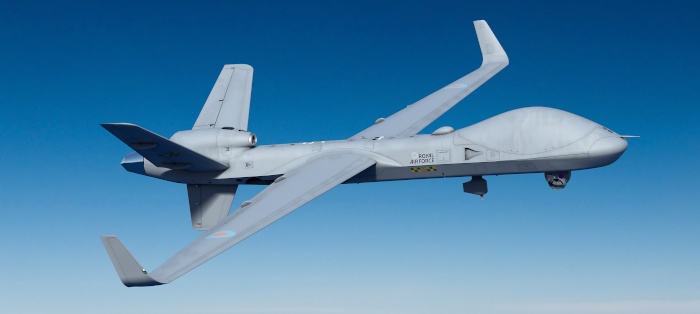 |
| Photo: Royal Air Force |
| Protector RG.1 (MQ-9B) |
General Atomics is also offering a specialized MQ-9B variant, which it calls the MQ-9B SeaGuardian. The SeaGuardian can be fitted with various mission kits for maritime purposes, including long-range maritime patrol and surveillance, sonobuoy dispensing, anti-submarine warfare and airborne mine-laying. Its operational radius for a typical mission is quoted as 2200 km (1200 nm).
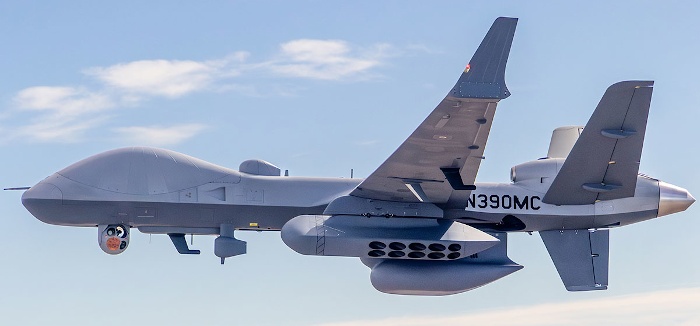 |
| Photo: General Atomics |
| SeaGuardian (MQ-9B) |
The latest variation of the MQ-9B theme is labeled MQ-9B STOL by General Atomics. It is a modified wing/tail kit, suitable for both the SkyGuardian and SeaGuardian, which significantly enhances the aircraft's STOL performance. This allows deployment to lower-standard expeditionary bases or large-deck amphibious warships. A promotional CGI video by GA-ASI shows a STOL SeaGuardian with foldable wings on an LHA type carrier deck.
Specifications
Note: Data given by several sources show slight variations. Figures given below may therefore be inaccurate!
Data for MQ-9A/B:
| MQ-9A | MQ-9B | |
|---|---|---|
| Length | 11 m (36 ft) | 11.6 m (38 ft) |
| Wingspan | 20 m (66 ft) | 24 m (79 ft) |
| Height | 3.56 m (11 ft 8 in) | ? |
| Weight | max: 4760 kg (10500 lb) empty: 1380 kg (3050 lb) | max: 5670 kg (12500 lb) |
| Speed | 445 km/h (240 knots) | 390 km/h (210 knots) |
| Ceiling | 15200 m (50000 ft) | > 12200 m (40000 ft) |
| Endurance | 27 h | > 40 h (SkyGuardian) > 30 h (SeaGuardian) |
| Propulsion | Honeywell TPE-331-10T turboprop; 670 kW (900 shp) | |
Main Sources
[1] Tom Kaminski: "The Future is Here", article in Combat Aircraft Vol. 4, No. 6, 2003
[2] Department of Defense Missile Nomenclature Records
[3] "Unmanned Aircraft Systems Roadmap, 2005-2030", Office of the Secretary of Defense, August 2005
[4] General Atomics: Remotely Piloted Aircraft, December 2024
[5] Various web resources, referenced by Wikipedia: General Atomics
MQ-9 Reaper
Back to Directory of U.S. Military Rockets and Missiles, Appendix 2
Last Updated: 30 December 2024